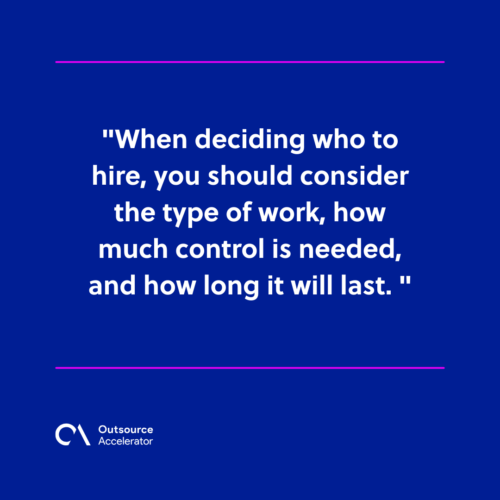Subcontractor vs. Employee: Differences explained

When developing your workforce, it’s important to understand the difference between subcontractors and employees.
Each has its own advantages and disadvantages, which affect aspects such as taxation, flexibility, and control.
This article will explain all the important points between a subcontractor vs. employee.
Subcontractor vs. Employee: Definition of terms
Before we delve deeper into the topic, let us first define both terms:
What is a subcontractor?
Are you thinking about hiring subcontractors for your next project? Let us guide you briefly about what a subcontractor is, including some pros and cons to consider.
A subcontractor is someone or a company that a main contractor, known as the prime contractor, brings in to handle specific tasks.
Subbies, as we call them, take care of their own taxes, insurance, equipment, and all that good stuff. The prime contractor focuses on the bigger picture, while subs handle certain pieces.
Advantages
Here are two essential benefits of hiring subbies:
- Flexibility. A subcontractor provides flexibility, especially if you need someone with a specialization. No need to have that staff on a permanent contract.
- Reduced overhead. As independent business entities, subbies save you long-term money since they handle their own overhead, including taxes, insurance, and other expenses.
Disadvantages
On the flip side, acquiring subcontractors also poses the following drawbacks:
- Limited control. When you hire subcontractors, you don’t have as much control over their daily work. If they’re busy with other jobs, it could cause delays for you. You also don’t have as much say in their methods.
- Dependency on availability. Availability may be an issue if the subcontractor is engaged in other projects simultaneously.

What is an employee?
Employees are people hired directly by your business, usually long-term. They’re fully integrated into your company structure, and you handle taxes, benefits, and everything else.
Advantages
Here are the benefits of hiring employees:
- Full control. Having full control means you get to determine schedules, methods, and company culture.
- Consistency. Employees also provide consistency for a stable workforce. You must invest more time into their onboarding and training to ensure they fully understand your company’s goals, objectives, and processes.
- Loyalty. Employees may develop a stronger sense of loyalty to your business over the long run as you become their primary employer.
Disadvantages
But just like employing a subcontractor, hiring in-house employees may also pose the following disadvantages:
- Costly. Employees do come with some added costs. Things like providing health insurance, retirement benefits, paid time off, and other standard employee benefits add to your expenses.
- Limits flexibility. There is less flexibility if your workload fluctuates a lot since it can be more difficult to adjust employee headcount up or down quickly.
Subcontractor vs. Employee: Key differences
Here are a few of the key differences between a subcontractor and an employee:
Tax differences
Subcontractors are self-employed, so they manage their own taxes like income and self-employment taxes. Employees have taxes withheld by the employer.
Independence
Subcontractors have more independence while employees work under your direction, following your procedures and schedules.
On the other hand, employees typically get benefits like health insurance and paid leave that subcontractors have to secure themselves.
Legal compliance and benefits
Subcontractors are independent and responsible for their own legal compliance as solo practitioners.
Compared to employees, benefits and incentives are typically not provided for subcontractors since they set their own project payment rates.
Tasks
On the plus side of subcontractors, they have more freedom to set their own schedules and work for multiple clients simultaneously.
Employers have more control over employee work hours and assigned tasks. It’s also important to properly classify workers to avoid any legal issues from misclassification.

Subcontractor vs. Employee: FAQs
Here, we have some of the frequently asked questions about subcontractors vs employees:
1. What are the main differences between subcontractors and employees?
The main difference comes down to control and taxes. Employees have a boss telling them what to do and when, and the company handles taking taxes out of their paychecks.
Subcontractors are pretty much their own boss – they have more freedom to do the work how and when they want. But they have to pay their own taxes, like filing as self-employed.
2. Are you legally responsible for misclassifying the two?
Yes. You’ve also gotta be careful about labeling someone correctly. Calling an employee a subcontractor when really they’re an employee can get you in hot water legally.
Companies need to follow labor laws and make sure any workers are properly classified.
3. How do their tax responsibilities differ?
Unlike employees, subcontractors are responsible for paying their own income tax and self-employment tax.
No one is taking taxes out of your checks for them – they must set money aside throughout the year to pay what they owe come tax time.
Subcontractor vs. Employee: Which should you hire?
There really isn’t a one-size-fits-all answer here. It comes down to looking at what your specific business needs are.
Do you need expertise on certain projects from time to time, or do you want more flexibility in who you bring on? Is having consistency and long-term commitment a higher priority?
You must weigh the pros and cons of a subcontractor vs. employee to see which model best fits your company’s goals.
When deciding who to hire, you should consider the type of work, how much control is needed, and how long it will last.

Subcontractors tend to work better for specialized tasks on projects, while employees are generally better for ongoing and integral roles.
Just make sure to follow all the labor laws no matter which one you go with.
Ultimately, it depends on your needs, the project’s requirements, and how much control you want.







 Independent
Independent




